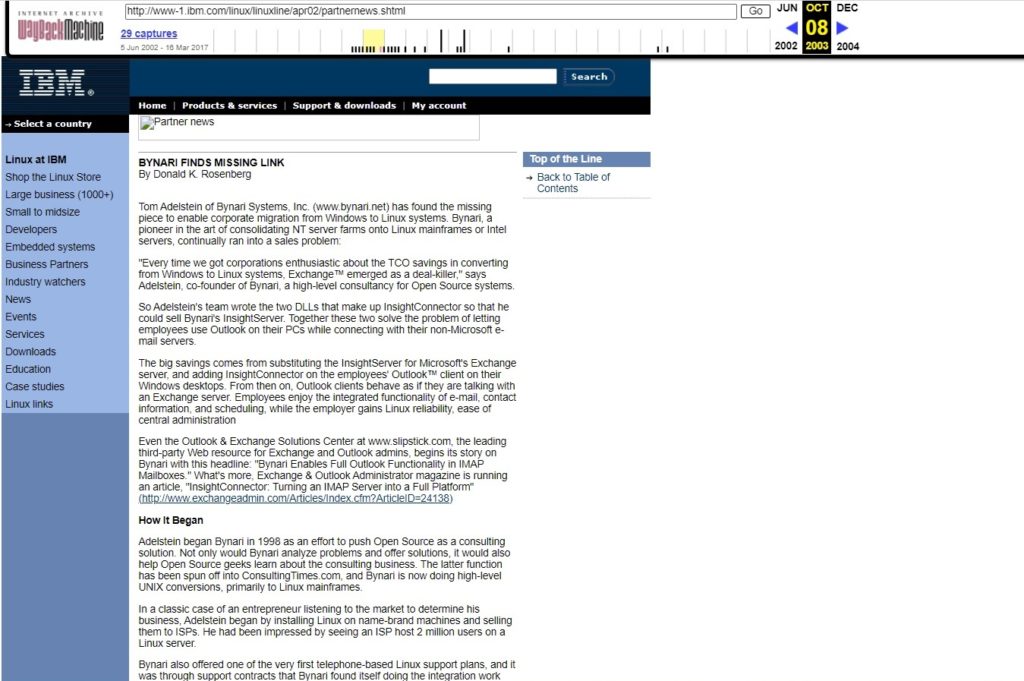Linux at IBM – Linux Line (archive.org)

BYNARI FINDS MISSING LINK
By Donald K. Rosenberg
Tom Adelstein of Bynari Systems, Inc. (www.bynari.net) has found the missing piece to enable corporate migration from Windows to Linux systems. Bynari, a pioneer in the art of consolidating NT server farms onto Linux mainframes or Intel servers, continually ran into a sales problem:
“Every time we got corporations enthusiastic about the TCO savings in converting from Windows to Linux systems, Exchange™ emerged as a deal-killer,” says Adelstein, co-founder of Bynari, a high-level consultancy for Open Source systems.
So Adelstein’s team wrote the two DLLs that make up InsightConnector so that he could sell Bynari’s InsightServer. Together these two solve the problem of letting employees use Outlook on their PCs while connecting with their non-Microsoft e-mail servers.
The big savings comes from substituting the InsightServer for Microsoft’s Exchange server, and adding InsightConnector on the employees’ Outlook™ client on their Windows desktops. From then on, Outlook clients behave as if they are talking with an Exchange server. Employees enjoy the integrated functionality of e-mail, contact information, and scheduling, while the employer gains Linux reliability, ease of central administration
Even the Outlook & Exchange Solutions Center at www.slipstick.com, the leading third-party Web resource for Exchange and Outlook admins, begins its story on Bynari with this headline: “Bynari Enables Full Outlook Functionality in IMAP Mailboxes.” What’s more, Exchange & Outlook Administrator magazine is running an article, “InsightConnector: Turning an IMAP Server into a Full Platform” (http://www.exchangeadmin.com/Articles/Index.cfm?ArticleID=24138)
How It Began
Adelstein began Bynari in 1998 as an effort to push Open Source as a consulting solution. Not only would Bynari analyze problems and offer solutions, it would also help Open Source geeks learn about the consulting business. The latter function has been spun off into ConsultingTimes.com, and Bynari is now doing high-level UNIX conversions, primarily to Linux mainframes.
In a classic case of an entrepreneur listening to the market to determine his business, Adelstein began by installing Linux on name-brand machines and selling them to ISPs. He had been impressed by seeing an ISP host 2 million users on a Linux server.
Bynari also offered one of the very first telephone-based Linux support plans, and it was through support contracts that Bynari found itself doing the integration work that it wanted. As name-brand vendors began to offer Linux on machines and other companies sprang up to offer to Linux telephone support packages, Bynari exited these markets in order to remain on the cutting edge of Open Source service.
Back in 1997, Adelstein saw that Outlook raised unique problems to corporations trying to consolidate and manage their data. The vital data contained in corporate e-mail was scattered across many servers in a corporation, typically at the department level. When petroleum giant Shell tried to use Digital Equipment Corp.’s Alta Vista Forum (based on the search engine) to consolidate corporate data, Microsoft MAPI mail and Lotus Notes™ could not be pulled into the new knowledge base. Adelstein solved the problem by piping the e-mail through Usenet.
When telephone maker Ericsson shifted from their own mainframe solution to Exchange to prevent Y2K problems, the 30% of users on Solaris found they had no e-mail to the rest of the company. He saw a critical need and started building a substitute for the Exchange server. It handled the e-mail, but customers began demanding even more functions, “such as shared calendaring and especially meeting management.”
Bynari added these features and more, and implemented them in IMAP and POP3 mode, not MAPI. All it took was a Bynari plug-in sitting as a proxy on the Exchange server. It would do the talking to UNIX. However, IT management objected to the third-party proxy component on the NT server. Adelstein, with the help of Linux advocates at Intel and Boeing, wrote new utilities that would work through the Internet. By this time, he realized that UNIX conversions involving Exchange and Outlook were a cutting-edge field in which he was rapidly acquiring expertise.
It has not been an easy road. And employees and employers alike insisted that Outlook functionality was too vital to lose.
Events of Change
Corporations interested in building knowledge bases had noticed the problems of pulling vital data out of e-mails that used proprietary transport protocols such as MAPI; Lotus Notes has since switched over to open protocols. But Bynari’s market was affected by the September 11th attacks on New York’s financial district. The loss of some of their NAS systems demonstrated to financial houses that they did not have proper backup and control of their distributed data as required not only by their business but by the SEC. The losses pushed them into considering a consolidated model. In addition, the spread of viruses crippled Exchange-based systems, in some cases costing retailers days of orders when internal order and credit-card systems could not be brought back up.
An even larger number of companies are looking at Microsoft licensing changes that are scheduled to become final at the end of July. They are delaying the deployment of Windows XP while they study the Exchange/Outlook data integration problems, and particularly the pulling of all data into Windows 2000’s Active Directory, a proprietary framework that will make the data even harder, if not impossible, to reach from other systems. Linux consolidations on the mainframe look increasingly good to these large-scale users.
Years of work solving individual problems and acquiring Exchange/Outlook expertise the hard way are now beginning to pay off. Bynari is the first IBM Linux Partner, and InsightConnector and InsightServer are ready to help companies consolidate and gain control of their data.
“Embrace and Extend” Meets Open Source
InsightConnector builds on the Exchange client piece, and persuades it to exchange mail with the InsightServer. Once Outlook believes it is in touch with an Exchange server, it unlocks its full functionality. But the Insight products use TCP rather than proprietary Microsoft transport protocols.
“Actually, the Microsoft proprietary protocols were originally UNIX: Microsoft got the Distributed Computing Environment (DCE) technology from the Open Group and made it the basis of OLE. Along with the DCE they got the Interface Definition Language (IDL); this is an application framework that sits atop a LAN. IBM used it at one time, but dropped it because it was too slow. But Microsoft tweaked the IDL into their own MIDL. They took advantage of IDL’s ability to do remote procedure calls to a server, and modified it so that it called whole libraries of functions on the server. So a lot of Outlook’s functions reside on the server, and the client expects to find them there.”
Bynari, on the other hand, takes an Open Source approach. InsightServer is built atop these unmodified pieces of Open Source software:
Cyrus IMAP Server, from Carnegie-Mellon University
http://asg.Web.cmu.edu/cyrus/
Exim MTA (Message Transfer Agent), from Cambridge University
http://www.exim.org/
Berkeley Database, from the University of California
http://db.cs.berkeley.edu/
GDBM GNU Database Libraries from Free Software Foundation
http://www.gnu.org/software/gdbm/gdbm.html
ProFTP from the ProFTPD Project
http://proftpd.linux.co.uk/
Apache HTTP Server from the Apache Foundation
http://httpd.apache.org/
Bynari has not modified these, and does provide the source code with the Open Source components. A /scr subdirectory is created at install time. Bynari adds a Web interface to manage the whole set of applications; for security reasons this interface is written in compiled C code rather than in Perl. The Command Line Interface (CLI) is still accessible, but not necessary if you are using the Web interface to manage the applications. The configuration scripts are open. The InsightConnector DLLs are, as Windows users would expect, binary-only code.
Bynari’s business model and revenues are based on product sales, not on service. The original InsightServer ran on the IBM zSeries™, but Bynari now has a full range of versions that run on the IBM S/390, the xSeries™ (Intel, suitable for the SMB market), iSeries™ (AS/400), and pSeries™ (RS/6000).
Adelstein is enthusiastic about his relationship with IBM, and repeatedly uses the word “wonderful” to describe it. Bynari has in turn reached a high road to helping IT managers come to grips with their dispersed data.
About Donald Rosenberg: Dr. Rosenberg is president of Stromian Technologies and author of Open Source: The Unauthorized White Papers (Wiley). He has worked with companies in the U.S. and Europe, both in Open Source and proprietary software. A speaker on Open Source business and licensing issues, he is on the advisory boards of several Open Source companies and a columnist for Linux Journal donr@stromian.com
